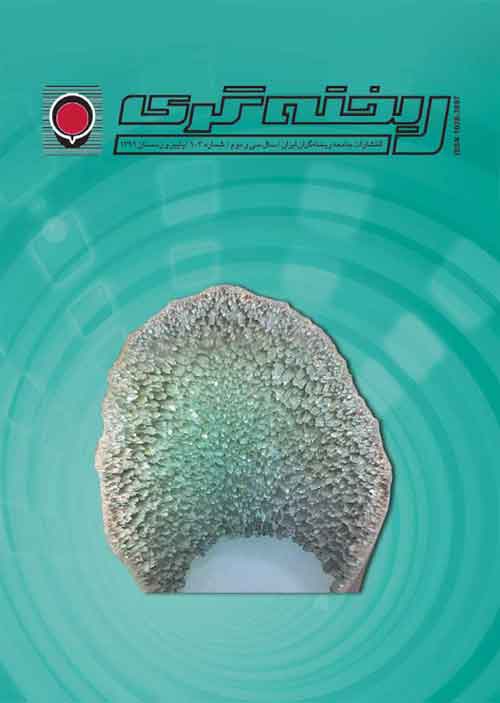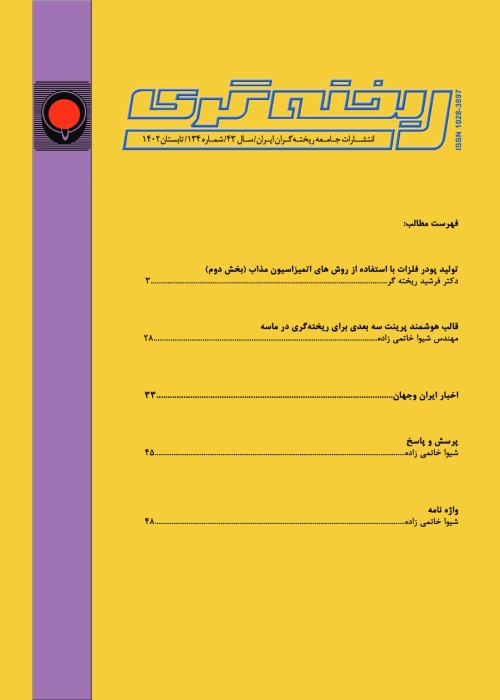فهرست مطالب

نشریه ریخته گری
پیاپی 103 (پاییز و زمستان 1392)
- تاریخ انتشار: 1392/12/20
- تعداد عناوین: 8
-
-
بررسی تاثیر محیط سردایش پس از عملیات انحلال کامل و تاثیر عملیات پیرسازی بر ریزساختار و سختی سوپرآلیاژ پایه نیکلی IN100صفحه 2
-
ارزیابی مکانیزم شکست در فولاد هادفیلدصفحه 12
-
بررسی تاثیر کلسیم بر ترمیم عیب اکسید فیلم دولایه در مذاب آلومینیمصفحه 18
-
اثر افزودن سیلیسیم بر رفتار انبساط حرارتی آلیاژ ریختگی برنج Cu-Zn40صفحه 25
-
تاثیر زمان ماند مذاب بر رفتار اکسید فیلم های دوتایی در آلیاژهای Al-0.8Mg-7.5%Si و Al-2%Mg-7.5Siصفحه 31
-
ریخته گری فوم آلومینیم A356 سلول بسته به کمک مخلوط مذاب و سیلیکون- دولومیت گرانوله و بررسی رفتار فشاری آنصفحه 38
-
تاثیر اندازه، شکل و توزیع سلول ها در فوم های چدن خاکستری تولید شده به روش ریختگی توسط گوی های ماسه ایصفحه 51
-
بررسی تاثیر گرافن بر خواص مکانیکی نانوکامپوزیت آلومینیم /گرافنصفحه 58
-
The effect of cooling rate after solution heat treatment and effect of aging treatment on the microstructure and hardness of cast Ni-based IN100 superalloyPage 2The purpose of this study is to investigate the effect of quenchant such as water, oil, air and furnace after solution heat treatment on the microstructure and hardness of cast Ni-based IN100 superalloy. In addition, the effect of aging cycle, has been studied. Results showed that, specimen cooled at the air has higher values of hardness because of volume fraction and size of primary γ which are 18±2% and 300±20 nm, respectively and also the presence offine secondary γ in the microstructure. The volume fraction and size of primary γ for specimen cooled with more cooling rate than air, has less value and no fine secondary γ has been detected. Furthermore, results showed that aging treatment caused an increase in volume fraction and size of primary γ and desired microstructure observed for specimen that cooled at air followed by aging at 900oC for 10hr.Keywords: Ni-based IN100 superalloy_Solutioning treatment_Cooling rate_Primary γ Aging treatment
-
Evaluation of fracture mechanism of Hadfield steelPage 12In this paper, the fracturebehavior of Hadfield steel as a function of plastic deformation and work hardening mechanisms are analyzed. The samples were produced using precision casting method. The tensile tests were performed on the samples after solution heat treatment.Using optical and scanning electron microscopes, the plastic deformation and fractography are analyzed.The results showed that the ductile fracture of Hadfield steel occurs without necking and of course, with high work hardening rate and high elongation. The fractography of tensile specimens showed that secondary micro-dimples between the primary dimples are present that could delay the fracturing and prevent necking.These micro-dimples dimensions are less than 1μm. They can be formed by micro-twinning interactions and Nano-carbide precipitation by dynamic strain aging phenomenon.Keywords: Hadfield Steel, Twinning Deformation, Fracture Behavior, Micro-dimple
-
Effect of Calcium on Healing of double oxide film defect in liquid AluminumPage 18The change in the composition of the oxide layers of a double oxide film defect held in aluminum melt containing 0.01 and 0.05wt% Ca and the possibility of formation of bonding between the two oxide layers of the defect has been studied in this work. For this purpose two alumina layers with a volume of air trapped between them were held in commercial purity Al melt at 750 oC for different periods of time between 4 to 180 min. Any change in the composition or morphology of the oxide layers was studied by SEM and EDX. The results showed that the formation of bonding between the two layers of the defect started due to transformation of alumina to an alumina silicate phase before the melting of the sample and increased gradually by time. The results also emphasized that the efficiency of the healing in these alloys depended on the amount of dissolved hydrogen in the melt.Keywords: double oxide film, healing, Aluminum-Calciumalloy, CA2, CA phases
-
Effect of Silicon on the thermal expansion behavior of cast Cu-Zn40 alloysPage 25Brass alloys are one of the most applicable alloys in todays industries. Addition of alloying elements is one of the strengthening and increasing corrosion resistance methods for these alloys. Silicon increases both the strength and corrosion resistance of brass. In this work, effect of the addition of silicon on the microstructure and the thermal expansion coefficient of CuZn40 was studied. Cast brass alloys with the silicon content of 0.1, 0.8 and 1.7 wt.% were prepared. Microstructure of samples was studied by both optical and scanning electron microscopy (SEM) methods. In addition, phase characterization of samples was done by XRD measurements. In order to determine the thermal behavior of samples dilatometric measurements were done. Results of this study showed that addition of silicon leads to formation of Cu-Zn-Si solid solution which in turn increases the amount of beta phase in the brass. In addition, an increment in the temperature increases the thermal expansion of brass and silicon brass alloys. Moreover, silicon by increasing the beta phase amount increases the thermal expansion coefficient of brass alloys.Keywords: Two phase brass, Silicon brass, Thermal expansion coefficient, Dilatometry
-
The effect of holding of melt on the behavior of double oxide film defects in Al-0.8%Mg-7.5%Si and Al-2%Mg-7.5%Si alloysPage 31In this study, the effect of maintaining the liquid metal on the healing of double oxide film defects and their role on the formation of gas pores has been studied using a reduced pressure test (RPT) technique. In order to produce double oxide film defects, the molten metal of Al-0.8%Mg-7.5%Si and Al-2%Mg-7.5%Si were poured into a second crucible from a certain height. The RPT samples were taken in certain intervals and the specifications of the pores observed at the cross-section of the RPT samples were determined by image analysis. The internal surfaces of the pores on RPT samples were also studied by SEM and EDX in order to determine the presence of any oxide layers. The results showed that in the melt containing 0.8 wt% Mg, the two layers bonded to each other after a while and this caused the pore roundness and %porosity of the RPT samples to decrease. In the melt containing 2 wt% Mg, the two layers did not bond to each other even though the rate of transformation of Al2O3 to MgAl2O4was higher than that of the melt with 0.8wt% Mg. This was attributed to the increase in the H content of the melt due to the higher concentration of Mg in the melt.Keywords: double oxide film defects, Magnesium, gas porosity
-
Casting of the closed-cell A356 metal foam by using mixture of the Silicon-Dolomite granules and the molten metalPage 38In this investigation has been developed an innovation method for production of A356 metal foam with high strength without usage to the reinforcement particles. Silicone rubber mixed with dolomite powder in order to increasing of thermal resistance. In this paper manufacturing process parameters such as size and percent of Silicon-Dolomite granules, pouring temperature, and cooling rate were measured and evaluated. Results show the 750oC temperature, 50 vol. % Silicon granule, and granules with 5 mm diameter are best production parameters. Comparison of pressure test results between this foam and others reinforced foam with SiC and TiB2 particles, shows that present foams have 8-12 more times plateau stress and approximately a reduction 1/4 in the densification strain.Keywords: Casting, A356 Al-foam, Silicone, Polystyrene, Closed-cell, compression strength
-
Effect of size, shape and distribution of cells in grey cast iron foam produced by casting process used of sand space holderPage 51Cellular materials and foams are types of engineering materials due to their unique characteristics can be applied successfully in many industrial applications. In this study, porous grey cast iron was produced using dry sand casting process that the sand balls was inserted into the sand moulds and effect of size, shape and distribution of the cells has been studied. Rotary kiln was used for melting of iron and four specimens of porous grey cast iron were produced with open cells and different size and shape of cells. The chemical composition of the specimens was determined and other tests were included measurement of porosity percents, compression tests, optical microscopic and scanning electron microscopic evaluation and radiography. The results are shown that the pearlite microstructure with A-type of graphite flakes is formed and radiography images are shown that the distribution of cells is more uniform in the specimen with smaller pores. In addition, in specimens with smaller cells, porosity percent is increased and density is decreased, as a result, the compressive strength is decreased.Keywords: Grey cast iron, Cellular materials, Compressive strength, Microstructure
-
Effect of graphene on mechanical properties of nanocomposite aluminum / graphenePage 58In this study, to produce this nano composite was used method mechanical alloying and hot pressing and were made pressure test samples. For this purpose, the mechanical alloying powders mentioned a maximum period of 10 hours in a ball mill abrasion was performed under argon atmosphere . The microstructure of the samples by RAMAN, XRD and SEM were examined , as well as to evaluate the mechanical properties, Brinell hardness test , and compressive strength of the samples were taken. Results show improved mechanical properties . Compared to pure aluminum, pure aluminum with 10 hours mill and Al/ graphene nanocomposite shows the increasing hardness (109 BHN) and increasing compressive strength (290MPa) in samples containing graphene is 0.2 percent.Keywords: nanocomposite, mechanical alloying, graphene


